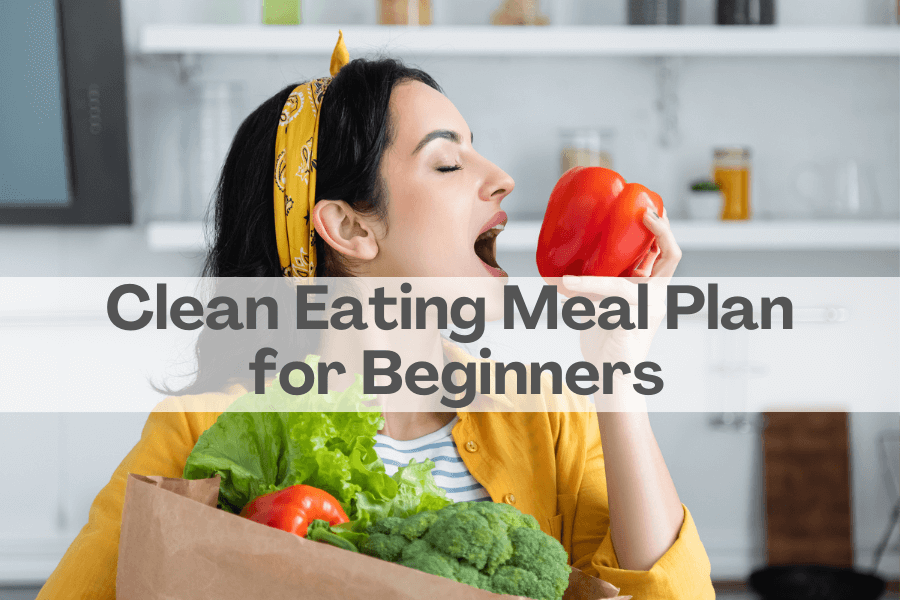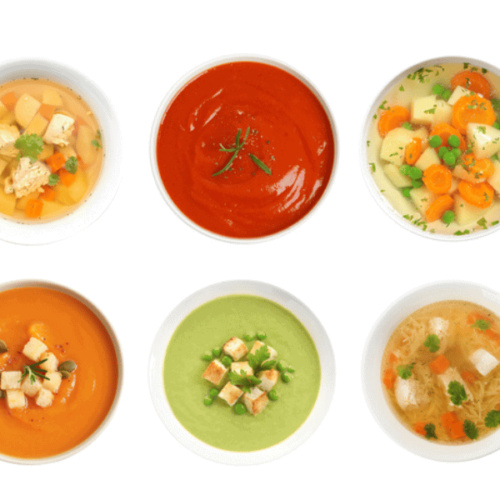Did you want to learn all about making a Clean Eating Meal Plan for Beginners?
Well, if you’re like most people, you probably think that clean eating is too hard and complicated. But it doesn’t have to be! In fact, with a little bit of planning, it can be super easy to eat clean.
Let’s get started!
Please note that we are not medical professionals and this post contains general information that should not replace the advice of your doctor or nurse.
 Eating clean has become a popular way to stay healthy and lose weight, but it can be intimidating for those who are just getting started.
Eating clean has become a popular way to stay healthy and lose weight, but it can be intimidating for those who are just getting started.
In this blog post, we’ll provide you with great tips on how to make a clean eating meal plan for beginners! We’ll cover topics such as food choices, elimination diets, meal preparation tips, and more.
By the end of this post, you’ll have all the knowledge necessary to create your own personalized clean eating program that works best for you.
This blog is all about a Clean Eating Meal Plan for Beginners.
Looking for more health tips to start your day off right? Check out our post on essential gut health habits that will pretty much change the way you start your day!
What is Clean Eating
Clean eating is a way of life that focuses on consuming whole, unprocessed foods. It’s about choosing nutrient-dense foods in their most natural state and avoiding those that are packed with chemicals, additives, and preservatives.
Clean eaters also limit added sugars while upping their intake of vitamins, minerals, fiber, and other essential nutrients through fruits and vegetables. The goal is to create an overall balance between healthful food choices without sacrificing taste or enjoyment!
Clean Eating Meal Plan for Beginners
1. Set your Clean Eating Goals
When it comes to clean eating, the first step is figuring out what goals you are trying to achieve with clean eating. Everyone starts the clean eating journey for different reasons and it becomes helpful to establish the overall goal you are trying to achieve.
The good news is, that clean eating can work wonders in a bunch of different areas – though your clean-eating meal plan may look a little different compared to someone else’s.
Before jumping right into clean eating, start by reflecting on what your individual goals are so that you can create an approach that works best for you.
Examples of Clean Eating Goals:
Losing Weight
If your goal of eating a clean diet is weight loss, one of the most important things to focus on is clean proteins and nutrient-rich veggies that are low in calories. Also, the elimination of processed foods and sugar (which is part of most clean meal plans) will naturally help you shed those extra pounds.
Reducing Inflammation
This is a very common reason to eat clean (and quite honestly, why I started). Clean diets are perfect for reducing inflammation and understanding how your body reacts to certain foods.
Boosting Your Immune System
Another great benefit of clean eating is increasing your body’s immunity. Since 70%-80% of immune cells live in your gut, it is important to nurture your gut with healthy eating as much as possible. Eating all the healthy anti-oxidant veggies and fruits will surely give your system an immunity boost.
Increased Energy and Well-being
Even if this is not your goal to begin with, it will surely be a very beneficial side effect of eating clean. Every time I remove all of the “bad guys” and focus on healthy vegetables, fruits, grains, etc., I almost always get a natural energy boost.
2. Elimination Diet for Clean Eating
One of the next places to focus on after setting your Clean Eating Goals is with an elimination diet.
An elimination diet is a dietary plan that involves removing certain foods or food groups from a person’s regular diet in order to identify potential food sensitivities and intolerances. The purpose of the elimination diet is to reduce inflammation in the body, improve digestive health, and optimize overall wellness.
Most elimination diets last for a few days up to a few weeks, and then slowly start introducing the eliminated foods back into your diet to see if any sort of reaction occurs.
Generally speaking, with elimination diets people eliminate common culprits like gluten, dairy, alcohol, etc. All of these are widely known to cause digestive distress and it’s really no surprise that these foods need to be avoided when doing an elimination diet.
Other foods such as eggs, soybeans, corn, etc. are also on the “do not eat” list while doing an elimination diet. Again, the overall goal of an elimination diet is to essentially reset your body and reduce possible irritation, any of these foods that can potentially cause harm are best to be avoided.
Elimination Diet Food List (foods NOT to eat)
- Processed or Packaged Foods
- Red Meat
- Dairy
- Gluten
- Soy
- Refined Grains (white flour, white rice)
- Refined sugar
- Alcohol
- Beans
- Corn
- Eggs
- Caffeine
3. Clean Eating Meal Plan for Beginners
Create a grocery list of all the clean eating staples you’ll need for your meals and snacks is our third step in eating clean. Be sure to include plenty of variety so you don’t get bored with your food choices.
Creating a clean eating meal plan doesn’t have to be intimidating; it’s all about stocking your pantry with smart staples that you can mix and match for an array of delicious dishes. Start your grocery trip with the basics like lean proteins, whole grains, fresh fruits, and vegetables. These will nourish your body and give you the energy you need to power through your day.
Don’t forget to switch up the varieties based on what’s in season or try new options so you don’t get bored. You can also throw in some clean-eating snacks like nuts, nut butters, seeds, and dried fruits for a healthy treat whenever cravings hit.
Have fun creating your clean-eating grocery list!
Clean Eating Food List
Since a list of what can be eaten on a clean diet is rather extensive, I think it’s best to reference one of the clean programs that I wholeheartedly love and follow, the Clean Program (by Alejandro Junger).
His approved list of foods is a great guide of what you should eat. A sample of what some of those yummy foods are:
Fruits
- Apples
- Blackberries
- Blueberries
- Cantaloupe
- Kiwi
- Raspberries
Vegetables
- Artichokes
- Arugula
- Avocado
- Broccoli
- Carrots
- Cucumber
- Kale
- Radishes
- Swiss Chard
- Zucchini
Beans
- Lentils
- Split peas
- Chickpeas
- Edamame
Cereals and Pasta
- Puffed brown rice
- Brown rice
- Kelp noodles
- 100% Buckwheat noodles
Meats & Fish
- Free-range chicken
- Duck
- Buffalo
- Salmon
- Halibut
- Tuna
Nuts and Seeds
- Almonds
- Cashews
- Pumpkin seeds
- Sesame seeds
- Walnuts
Dairy Substitutes
- Almond milk
- Hemp milk
- Coconut milk
- Rice milk
Beverages
- Teas (herbal)
- Mineral water
- Freshly squeezed fruit and vegetable juice (from clean-approved fruits and vegetables)
Again, this is only a sample of what can be eaten. Please review this Clean Program list for a more detailed food list.
3. Clean Eating Meal prep
After you have an idea of which foods you want to buy and which meals you want to make, start prepping your meals. This step is key to making sure you actually stick to your clean eating plan.
Choose a few recipes that you can make ahead of time and cook them in bulk so they’re ready to go when hunger strikes.
Meal prepping is a great way to stay on track with your clean-eating meal plan. Taking the time out of your week to do a bit of prep will make it so much easier to hit your goals!
Meal prepping can range from basic plans – such as cutting up vegetables for easy snack access – to setting aside an afternoon to make some of your favorite recipes that you can eat throughout the week.
Choose one or two recipes at a time, scale them up, and cook them in bulk! With some delicious meals ready for reheating, following up with clean eating snacks will be simple – leaving you more time and energy for the rest of your day!
5. Track Your Progress
Finally, stay motivated by tracking your progress and celebrating small victories along the way. Keep a food journal or take photos of yourself to see the physical changes that occur as a result of eating clean.
Staying motivated is essential for any health and fitness journey, so don’t underestimate the power of tracking your progress and celebrating small victories. Keeping a food journal or taking progress pictures can help you stay on track, as little reminders of how far you’ve come.
Plus, after each accomplishment or milestone achieved—no matter how big or small—it’s important to take some time to appreciate all of your hard work! Not only can this help to build your confidence, but it’ll also motivate and inspire you even further.
Looking for Eating Clean Tips?
If you are an information junkie like I am, I highly recommend you check out Alejandro Junger’s book, Clean.![Clean - The Revolutionary Program to Restore the Body's Natural Ability to Heal Itself by [Alejandro Junger, Amely Greven]](https://m.media-amazon.com/images/I/51WhJQp3sdL.jpg)
When I did my first clean diet, this was my go-to resource and guide through my clean eating process. Dr. Junger provides extensive research and information on this subject, as well as delicious recipes (that I found especially helpful when feeling stuck on what to eat during the elimination diet phase).
I highly recommend it as a resource for clean eating!
Eating clean can be an incredibly rewarding experience that brings more than just physical benefits.
You may shed a few extra pounds and have more energy, but you will also strengthen your relationship with food and learn how to nourish your body with wholesome ingredients.
By committing to the process, you can transform your eating habits into healthier ones that are easier to sustain in the long run.
Get started on your journey today by taking small steps such as determining your goals, researching clean eating staples, creating a grocery list, planning ahead with meal prep, and tracking your progress.
With dedication and hard work, you can reach all of the amazing accomplishments that come from eating clean.



